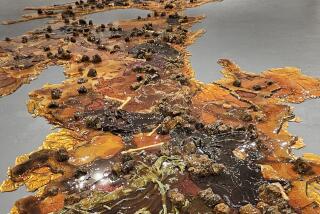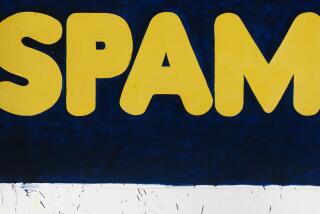L.A. Artist Alexander Plays With Fire : Exhibit: He discusses his depiction of the City of Angels ablaze during lecture Thursday at the Laguna Art Museum, where his works are on view.
LAGUNA BEACH — “First of all, this has nothing to do with the riots,” Los Angeles artist Peter Alexander recently said of his works that depict the city ablaze.
“My fantasy of L.A. burning was more about reseeding, rejuvenation,” he said, although it also has to do with an old belief that the land of earthquakes and fires is indeed prone to “self-destruction.”
“Even the Indians had that idea,” he said.
A key figure on the Southern California art scene for 25 years, Alexander explained his fascination with Los Angeles on fire during a brief lecture Thursday at the Laguna Art Museum, where his works are on view.
The exhibit, “Century: A Painting by Peter Alexander,” takes its title from the show’s centerpiece, “Century, 1990,” a large aerial view of Los Angeles at night, the city’s brilliant lights blurred, as though seen through an airplane’s misted-over window. What appears to be a dense, dark fog bank creeps over the grid of streets and avenues below.
The creeping bank represents an interplay of “smog, fog and fire,” Alexander said. But rather than painting raging red or orange flames, he used only black and white. He isn’t fond of overheated, Wagnerian aesthetics, and black and white “always refer to black-and-white photographs and I like that reference--it gives the work another kind of density,” he said.
Alexander’s flame fixation began in 1975, when he made drawings for the film “The Day of the Locust,” in which the City of Angels faces a disastrous fire. It was a perfect assignment for someone intrigued by the idea of Los Angeles’ “emotional,” as well as its geological, vulnerabilities. The city, he felt, was entrenched in the flimsy fantasies of Hollywood, not just sitting on several faults.
When there was a fire at Universal Studios in 1990, he stayed up all night to photograph television transmissions of the melee. These photos and others, which he referred to as he painted later, are included in the exhibit, designed to explore his step-by-step working process.
“I had no vindictiveness against Universal, but I was overjoyed because the idea of the fantasy going up in flames was so exciting,” he said.
Alexander, 53, was born in Los Angeles but spent part of his childhood in Newport Beach, where his father sailed and he surfed. Always interested in qualities of color and light, he made sculptures from glistening cast polyester resin--out of which surfboards are made. In the mid-’60s, he became part of the “Finish Fetish” and “Light and Space” movements.
After graduating UCLA in 1968 with a master’s in art, he painted abstracts on black velvet and made pastel drawings of sunsets, aided by a west-facing house he was building in the Santa Monica mountains.
“I kept seeing these incredible sunsets,” he said, and wanted to capture their beauty as well as react to then-popular Minimalism, which he felt was basically a “crock.” “I really wanted to make a picture--a real, dumb picture.”
For the past decade, Alexander has focused mostly on landscapes, whether sunsets or scenes of Los Angeles after dark, often taking titles for the works out of the Thomas Guide. Lately, he’s been making black-and-white paintings of Las Vegas, struggling to convey the glitzy city’s glaring illumination, at once beautiful and repulsive, he said.
Intrigued early on by Claude Monet and Jan Vermeer, Alexander still feels compelled to investigate qualities of light.
“The lights in Vegas--you like them and you hate them,” he said. “How do you paint that? That’s an interesting problem.
“Light does have a power,” he said. Quoting a favorite aphorism, he added, “Of all objects of perception, light arouses the greatest desire,” a saying that speaks to “sensuousness, which I think light is about, or at least is what I like about it.”
“Century: A Painting by Peter Alexander” runs through July 19 at Laguna Art Museum, 307 Cliff Drive, Laguna Beach. Hours: 11 a.m. to 5 p.m. Tuesday through Sunday. $3, adults; $1.50, senior citizens and students. (714) 494-8971.
More to Read
The biggest entertainment stories
Get our big stories about Hollywood, film, television, music, arts, culture and more right in your inbox as soon as they publish.
You may occasionally receive promotional content from the Los Angeles Times.










